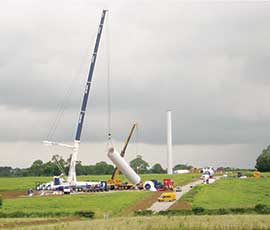Take swift action to beat wind and AD tariff cuts

Feed-in Tariffs (FiTs) for new wind turbines and smaller-scale biogas plants are set for a 20% cut from next April and farmers need to act fast if they are to lock into existing support rates.
The cuts are part of the Department of Energy and Climate Change’s (DECC’s) degression system, which imposes progressive cuts to support when installed capacity exceeds certain thresholds (see table).
The annual threshold for the maximum 20% cut has already been exceeded for all wind turbines and AD plants smaller than 500kW. FiTs for 500kW-5MW AD are set for at least a 5% cut and deployed hydro capacity is also likely to exceed the trigger for a 5% cut by the end of the year, according to Fisher German.
Solar PV support is subject to more regular reviews based on quarterly uptake. DECC figures for July to September show there were not enough new solar installations up to 50kW (the most common farm-based size) to trigger any degression, so current rates will remain until April 2014, when a mandatory 3.5% cut comes in. FiTs for new PV installations larger than 50kW will also face a 3.5% cut from January 2014.
Fisher German’s head of renewable energy Mark Newton says some renewable energy project developers with planning permission and grid connection confirmed can apply for preliminary accreditation for FiTs before 31 December. This allows them to lock into the higher rate for the lifetime of the project. Installations must be commissioned within a reasonable time of the pre-accreditation; one year for wind turbines and AD, six months for solar and two years for hydro schemes.
“The preliminary accreditation process is reasonably straightforward and provided you have the application in before 31 December, you should be OK. But you need to have planning permission and grid connection in place before that to qualify, so if you haven’t started that process it’s probably too late,” says Mr Newton. “Just having a grid offer is no good – you must have either paid a deposit or paid in full to secure the connection.”
People with renewable energy projects already being built have until 31 March 2014 to get systems up and running and exporting electricity to qualify for the existing FiTs rates, but if that timescale is tight, Mr Newton advises considering pre-accreditation to reduce risk of missing out on the higher FiTs in the event of unforeseen delays.
| Key points |
|---|
|
Securing grid connection is getting increasingly difficult as the network is close to capacity in many areas, he adds. “There aren’t many parts of the country where there’s much spare grid capacity now and it’s really starting to restrict the development of renewables across the UK. If you’re planning a new project, it’s vital to check capacity at an early stage and also whether other projects are planned in that area that could use up spare capacity too. It may be worth paying a deposit early to secure your grid connection.”
Margins squeezed
Mr Newton said the proposed cuts to FiTs presented a real challenge for developers of new wind turbines in particular, as costs had not really fallen in recent years.
“A typical 50kW turbine costs about £250,000-300,000 to build and generates about £35,000-50,000 a year. That cost hasn’t really changed over the past two or three years, yet we’re now looking at a 20% reduction in support.”
In contrast, the cost of building a 50kW solar array has fallen from £135,000 two-and-a-half years ago to nearer £50,000 now. “Solar FiTs have come down dramatically in that time to reflect this,” he says.
As energy prices continue to increase, greater electricity savings through more on-site use and sales of electricity exported to the grid may help to offset falling FiTs payments, he adds. “Up to 6p/kWh is now achievable through a power purchase agreement.”
Good returns will therefore still be possible under the lower FiTs, provided turbines are correctly positioned on sites with good wind speeds, he says.
| Non-solar renewables uptake | |||
|---|---|---|---|
| Technology type | Number of installations (1 Jan-30 Sept 2013) | Aggregate installed capacity (1 Jan-30 Sept 2013) kW | Tariff degression |
| Wind (0-100kW) | 508 | 21,111 | 20% |
| Wind (>100kW-5MW) | 132 | 91,932 | 20% |
| AD (0-500kW) | 23 | 9,549 | 20% |
| AD (>500kW-5MW) | 14 | 20,209 | 5% |
| Hydro (all) | 89 | 11,513 | 2.5% (5% likely) |
| Source: www.gov.uk/government/statistical-data-sets/monthly-mcs-and-roofit-statistics | |||
